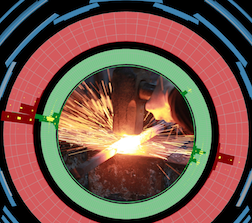Speaker
Description
The renormalizable coloron model, which has previously been shown in the literature to be
consistent with a wide array of theoretical and precision electroweak constraints, includes a pair of spinless bosons (one scalar, one pseudoscalar). We show that either of them, or both together if they are degenerate, could be responsible for the diphoton resonance signal for which both CMS and ATLAS have seen evidence. Because either of these bosons would be produced and decay through loops of spectator fermions, the absence of signals in dijet, t?t, and electroweak boson pair channels is not a surprise.
Summary
The renormalizable coloron model, which has previously been shown in the literature to be
consistent with a wide array of theoretical and precision electroweak constraints, includes a pair of spinless bosons (one scalar, one pseudoscalar). We show that either of them, or both together if they are degenerate, could be responsible for the diphoton resonance signal for which both CMS and ATLAS have seen evidence. Because either of these bosons would be produced and decay through loops of spectator fermions, the absence of signals in dijet, t?t, and electroweak boson pair channels is not a surprise.
